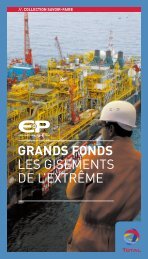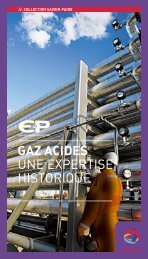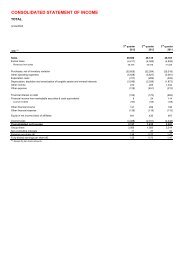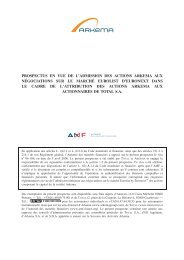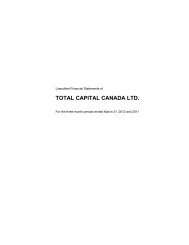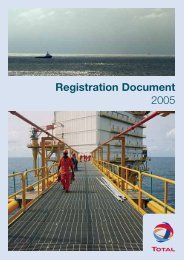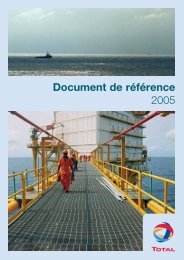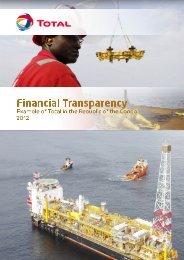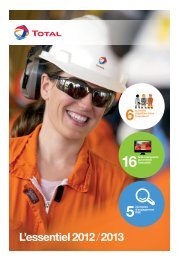Registration document 2007 - Total.com
Registration document 2007 - Total.com
Registration document 2007 - Total.com
You also want an ePaper? Increase the reach of your titles
YUMPU automatically turns print PDFs into web optimized ePapers that Google loves.
9<br />
flows with the zero coupon interest rate curves existing at<br />
year-end;<br />
• other financial instruments: the fair value of the interest rate<br />
swaps and of FRA (Forward Right Agreement) are calculated<br />
by discounting future cash flows on the basis of the zero<br />
coupon interest rate curves existing at year-end after<br />
adjustment for interest accrued yet unpaid.<br />
Forward exchange contracts and currency swaps are valued on<br />
the basis of a <strong>com</strong>parison of the forward rates negotiated with<br />
the rates in effect on the financial markets at year-end for similar<br />
maturities.<br />
Exchange options are valued based on the Garman-Kohlhagen<br />
model including market quotations at year-end.<br />
N. Inventories<br />
Inventories are valued in the consolidated financial statements at<br />
the lower of historical cost and market value. Costs for petroleum<br />
and petrochemical products are determined according to the<br />
FIFO (First-In, First-Out) method and those of other inventories<br />
using the weighted-average cost method.<br />
Downstream (Refining – Marketing)<br />
Petroleum product inventories are mainly <strong>com</strong>prised of crude oil<br />
and refined products. Refined products principally consist of<br />
gasoline, kerosene, diesel, fuel and heating oil and are produced<br />
by the Group’s refineries. The turnover of petroleum products<br />
does not exceed two months on average.<br />
Crude oil costs include raw material and receipt costs. Refining<br />
costs principally include the crude oil costs, production costs<br />
(energy, labor, depreciation of producing assets) and allocation of<br />
production overhead (taxes, maintenance, insurance, etc.). Startup<br />
costs and general administrative costs are excluded from the<br />
cost price of refined products.<br />
Chemicals<br />
Costs of chemical products inventories consist of raw material<br />
costs, direct labor costs and an allocation of production<br />
overhead. Start-up costs and general administrative costs are<br />
excluded from the cost of inventories of chemicals products.<br />
O. Treasury shares<br />
Treasury shares of the parent <strong>com</strong>pany held by its subsidiaries or<br />
itself, are deducted from consolidated shareholders’ equity. Gains<br />
or losses on sales of treasury shares are excluded from the<br />
determination of net in<strong>com</strong>e and are recognized in shareholders’<br />
equity.<br />
P. Other non-current liabilities<br />
Non-current liabilities <strong>com</strong>prise liabilities for which the amount<br />
and the timing are uncertain. They arise from environmental risks,<br />
legal and tax risks, litigation and other risks.<br />
178<br />
Appendix 1 – Consolidated financial statements<br />
Notes to the consolidated financial statement<br />
TOTAL – <strong>Registration</strong> Document 2006<br />
A provision is recognized when the Group has a present<br />
obligation (legal or constructive) as a result of a past event for<br />
which it is probable that an outflow of resources will be required<br />
and when a reliable estimate can be made of the amount of the<br />
obligation. The amount of the liability corresponds to the best<br />
possible estimate.<br />
Q. Asset retirement obligations<br />
Asset retirement obligations, which result from a legal or<br />
constructive obligation, are recognized on the basis of a<br />
reasonable estimate of their fair value in the period in which the<br />
obligation arises.<br />
The associated asset retirement costs are capitalized as part of<br />
the carrying amount of the long-lived assets and depreciated<br />
over the useful life of the associated long-lived asset.<br />
An entity is required to measure changes in the liability for an<br />
asset retirement obligation due to the passage of time (accretion)<br />
by applying a discount rate that reflects the time value of money<br />
to the amount of the liability at the beginning of the period. The<br />
increase of the provision due to the passage of time is<br />
recognized as “Other financial expense”.<br />
R. Employee benefits<br />
In accordance with the laws and practices of each country, the<br />
Group participates in employee benefit plans offering retirement,<br />
death and disability, healthcare and special termination benefits.<br />
These plans provide benefits based on various factors such as<br />
length of service, salaries, and contributions made to the<br />
governmental bodies responsible for the payment of benefits.<br />
These plans can be either defined contribution or defined benefit<br />
pension plans and may be entirely or partially funded with<br />
investments made in various non-Group instruments such as<br />
mutual funds, insurance contracts, and others.<br />
For defined contribution plans, expenses correspond to the<br />
contributions paid.<br />
Defined benefit obligations are determined according to the<br />
Projected Unit Method. Actuarial gains and losses may arise from<br />
differences between actuarial valuation and projected<br />
<strong>com</strong>mitments (depending on new calculations or assumptions)<br />
and between projected and actual return of plan assets.<br />
The Group applies the corridor method to amortize its actuarial<br />
gains and losses. This method amortizes the net cumulative<br />
actuarial gains and losses that exceed 10% of the greater of the<br />
present value of the defined benefit obligation and the fair value<br />
of plan assets, over the average expected remaining working<br />
lives of the employees participating in the plan.<br />
In case of a change in or creation of a plan, the vested portion of<br />
the cost of past services is recorded immediately in the in<strong>com</strong>e<br />
statement, and the unvested past service cost is amortized over<br />
the vesting period.




